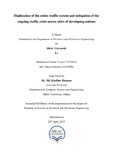Digitization of the entire traffic system and mitigation of the ongoing traffic crisis across cities of developing nations
Abstract
This paper focuses on a novel approach for handling the present traffic situation in perspective of Bangladesh. We plan to moderate the ongoing traffic predicament that currently plagues Dhaka city and gradually expand it to the whole country. Road traffic congestion is apparently a borderless ordeal in Dhaka and its adjacent cities and the situation tends to worsen as new cars enter the current stream every day. The aim of the paper is to develop a threefold solution to counter the traffic clogging. The approach taken during the course of this research focused primarily on an experimental evaluation of the small-scale model of the traffic routing algorithms. Among the threefold solution, the first approach is to develop a traffic algorithm to calculate the routes with shortest possible times to destinations. We plan to implement the system‟s usability by providing feedback to our target users (car drivers) so that they can decide on which route to take. This will be done by means of an overhead display on the car dashboards backed up by an embedded OS or Android. For our input we plan to take the amount of cars that are at any specific route at a time and provide that data to the car driver by the means of modern vehicle density measurement techniques. Travelling times are calculated using Dijkstra‟s algorithm and the shortest possible time required is provided to the commuters taking into consideration the situation of the roads at any point of time. The second approach is to make use of 24-hour Dynamic Traffic Light Controllers (DTLCs) based on artificial neural networks. The DTLC will be implemented using the Intel NUC in conjunction with the Arduino Mega. The decision making algorithm is designed to replicate, in a meager form, the human brain with the system trained to learn to respond to certain traffic situations. At present the BRTA (Bangladesh Road Transport) employs Static Traffic Light Controllers (STLCs) to handle traffic flow at some intersections while other, less important, ones have manual control in the form of the traffic officer in charge.

